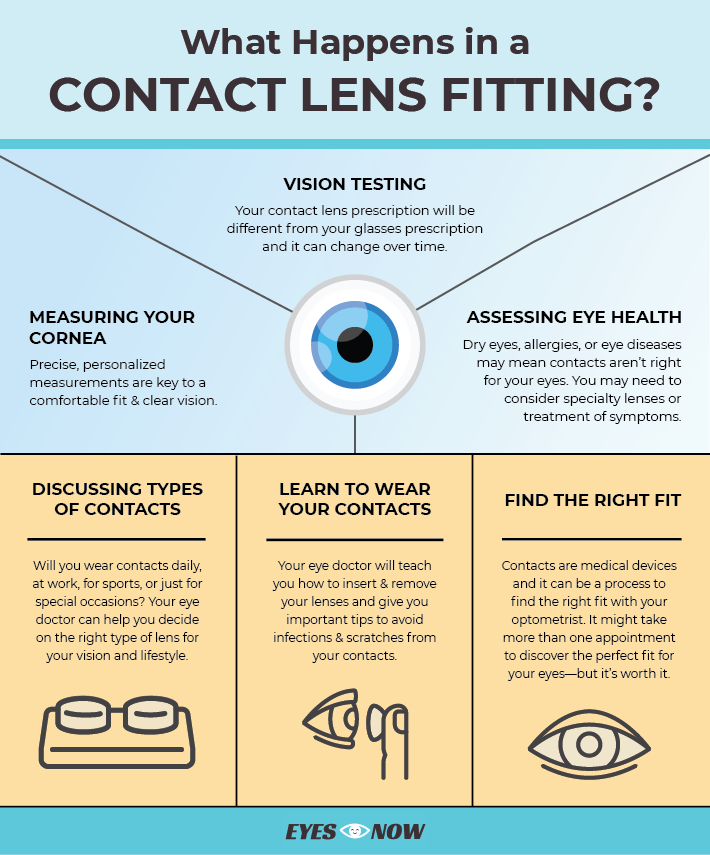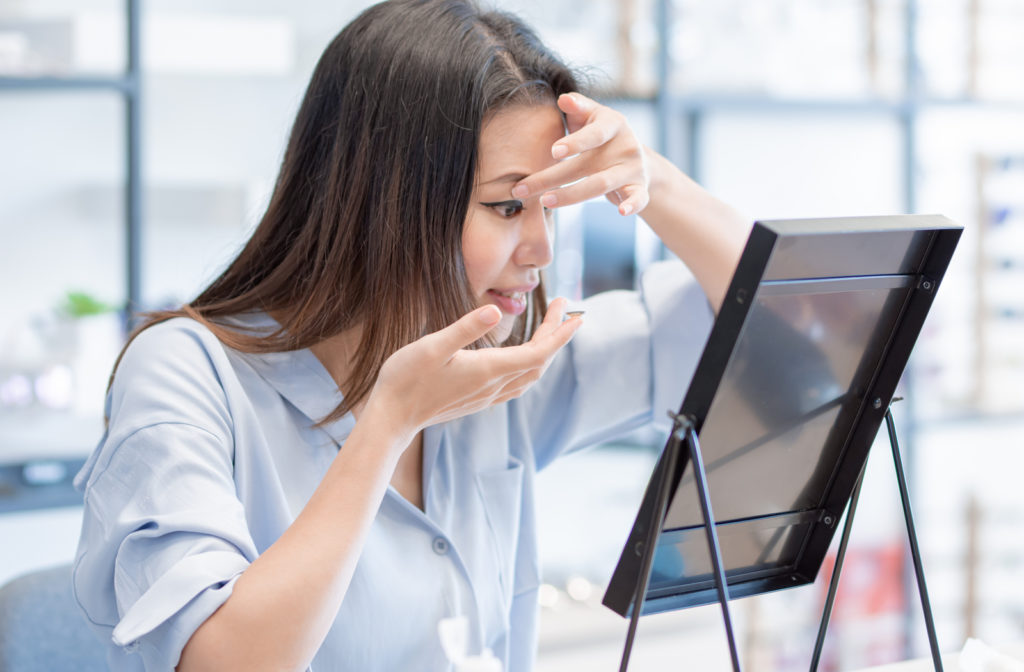Contact lenses can be a great way to gain clear, comfortable vision without dealing with glasses. But when the fit of your lenses isn’t right, your vision can suffer.
If you want to start wearing contacts, or if your current contacts have become uncomfortable or offer less than crystal-clear vision, a contact lens exam and fitting at your eye doctor’s office is essential.
A comprehensive contact lens exam and fitting gives your eye doctor a chance to measure your eyes, check their health, and help you find a comfortable fit, type, and brand of contact lens that suits your life. Here’s what you can expect from these appointments.

Step 1: The Contact Lens Eye Exam
A contact lens prescription is different from your eyeglasses prescription, in part because your contacts sit directly on your eyes. Your exam will include a discussion of your plans for contacts, including how often you’ll wear them, an assessment of your vision and eye health, and precise measurements to fit your contacts.
Discussing Types of Contact Lenses
In your eye exam, your optometrist can answer any questions you have about wearing contacts, including what kind of lenses might be right for you, like daily disposables or monthlies.
Dailies are easy because you throw them out after wear and don’t need to worry about cleaning and storing them, though they can be more prone to tearing and generally cost a bit more. They might make sense for you if you only plan to wear your contacts once in a while, like for special occasions, or if you don’t want to deal with cleaning lenses every day. Monthlies can be more affordable and durable for regular wear, and can be more affordable.
You can also talk to your eye doctor about soft contact lenses versus rigid gas permeable (RGP) lenses. Soft contacts are the most commonly prescribed contacts and are quite comfortable right away for most wearers.
Some people prefer the clarity of vision and dry eye relief they get from RGP lenses. RGPs can also be a better option for people with a high astigmatism prescription. The downside of RGPs is that the more rigid lens material can take longer to get used to wearing.
Hybrid lenses combine the clarity of RGPs with the comfort of soft contacts, though they’re a more expensive option.
The Health of Your Eyes
Your optometrist will assess the health of your eyes to make sure contacts are a safe and comfortable vision correction option for you.
Some people with dry eyes will need to treat their symptoms first before they can wear contacts, because contacts can make dry eyes worse, or even cause damage to the cornea. Some people with dry eyes may be able to wear specialty contacts, like scleral lenses, successfully.
Some severe allergies might also make contact lens wear uncomfortable and inadvisable. However, your eye doctor may be able to recommend a change in allergy medication or lens type (for example from monthlies to daily disposables) that can help.
Testing Your Vision & Measuring Your Eyes
Your optometrist will test your vision and take detailed measurements of the surface of your eye. They will use a keratometer to determine the curvature of your cornea and to measure the degree of astigmatism if present. (People with astigmatism can get great vision from contact lenses, but it generally takes a little longer to find the right fit.)
Your doctor might also use corneal topography to take a detailed 3D map of the surface of your eye. And they may measure your iris and pupil, either with a ruler or an automated device.
If you’re a good candidate for wearing contacts, your eye doctor might be able to proceed with a lens fitting right away. But if you require specialty lenses they will need to order the lenses into the clinic ahead of a separate fitting appointment.

Step 2: The Contact Lens Fitting Appointment
In your contact lens fitting, you’ll learn how to insert and remove your contacts if contacts are new for you. It can be a bit strange to touch the surface of your eye at first, so give yourself time to adjust to the new sensation.
Your doctor can assess your eyes and vision after a few minutes of wear. They will check the clarity of your vision, ask you about comfort, and view the surface of your eye with a slit lamp microscope.
Depending on the results of this initial assessment, you’ll be asked to wear your contacts for at least a few hours, or take them home and wear them frequently over the next several days or weeks so your eye doctor can assess the fit, your comfort, and your visual acuity after some wear time.
If you’re not satisfied with your contacts for any reason—from the quality of your vision to how they feel on your eye—you can work with your doctor to find a better fit. And once you find that right fit, your doctor will let you know when you should schedule your next eye exam. People who wear contact lenses should typically see their optometrist at least once a year.
Things to Know About Contact Lens Hygiene
When you wear contact lenses, you’re coming in close contact with the surface of your eye regularly, putting you at an increased risk of eye infections and scratches to the cornea.
In your fitting appointment, your doctor will give you directions on taking care of your eyes and your contacts. Some good basic hygiene guidelines can help you reduce those risks and keep your eyes healthier, including:
- Wash your hands before inserting & removing your lenses
- Always rub & rinse your lenses, even if you use a “no-rub” solution
- Always use the recommended cleaning solution, and use fresh solution every time you clean & store your lenses
- Replace your lenses on the schedule recommended by your eye doctor
- Replace your lens case at least every 3 months
- Don’t wear your lenses while swimming
- Never share your lenses with someone else
Book Your Contact Lens Exam & Fitting
If you’re excited to wear contact lenses, make the first step by booking a contact lens exam and fitting with Eyes Now. Our experienced optometrists can help you find the right lens for your life.



